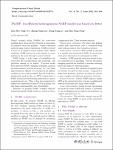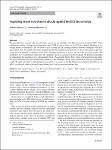Search
Author
- Jorgensen, Ed (3)
- McFadyen, Ron (3)
- Nora, El-Rashidy (3)
- Christian, Homeyer (2)
- next >
Subject
- programming (10)
- Open Access (8)
- Java (7)
- Programming (7)
- next >
Date issued
- 2020 - 2025 (293)
- 2010 - 2019 (39)
- 2000 - 2009 (2)
- 1999 - 1999 (1)
Has File(s)
- true (335)
Search Results
Computing the directed path-width of a directed graph is an NP-hard problem. Even for digraphs of maximum semi-degree 3 the problem remains hard. We propose a decomposition of an input digraph G = (V,A) by a number k of sequences with entries from V, such that (u,v) ∈ A if and only if in one of the sequences there is an occurrence of u appearing before an occurrence of v. We present several graph theoretical properties of these digraphs. Among these we give forbidden subdigraphs of digraphs which can be defined by k = 1 sequence, which is a subclass of semicomplete digraphs. |
Since its emergence in the 1960s, Artificial Intelligence (AI) has grown to conquer many technology products and their fields of application. Machine learning, as a major part of the current AI solutions, can learn from the data and through experience to reach high performance on various tasks. This growing success of AI algorithms has led to a need for interpretability to understand opaque models such as deep neural networks. Various requirements have been raised from different domains, together with numerous tools to debug, justify outcomes, and establish the safety, fairness and reliability of the models. |
Image processing is a very broad field containing various areas, including image super-resolution (ISR) which re-represents a low-resolution image as a high-resolution one through a certain means of image transformation. The problem with most of the existing ISR methods is that they are devised for the condition in which sufficient training data is expected to be available. This article proposes a new approach for sparse data-based (rather than sufficient training data-based) ISR, by the use of an ANFIS (Adaptive Network-based Fuzzy Inference System) interpolation technique. |
This paper presents an investigation of speaker adaptation using a continuous vocoder for parametric text-to-speech (TTS) synthesis. In purposes that demand low computational complexity, conventional vocoder-based statistical parametric speech synthesis can be preferable. While capable of remarkable naturalness, recent neural vocoders nonetheless fall short of the criteria for real-time synthesis. We investigate our former continuous vocoder, in which the excitation is characterized employing two one-dimensional parameters: Maximum Voiced Frequency and continuous fundamental frequency (F0). |
Achieving maximum parallel performance on multi-core CPUs and many-core GPUs is a challenging task depending on multiple factors. These include, for example, the number and granularity of the computations or the use of the memories of the devices. In this paper, we assess those factors by evaluating and comparing different parallelizations of the same problem on a multiprocessor containing a CPU with 40 cores and four P100 GPUs with Pascal architecture. We use, as study case, the convolutional operation behind a non-standard finite element mesh truncation technique in the context of open region electromagnetic wave propagation problems. |
The images or other third party material in this article are included in the article’s Creative Commons licence, unless indicated otherwise in a credit line to the material. If material is not included in the article’s Creative Commons licence and your intended use is not permitted by statutory regulation or exceeds the permitted use, you will need to obtain permission directly from the copyright holder. |
We present a novel hypergraph-based framework enabling an assessment of the importance of binary classification data elements. Specifically, we apply the hypergraph model to rate data samples’ and categorical feature values’ relevance to classification labels. The proposed Hypergraph-based Importance ratings are theoretically grounded on the hypergraph cut conductance minimization concept. As a result of using hypergraph representation, which is a lossless representation from the perspective of higher-order relationships in data, our approach allows for more precise exploitation of the information on feature and sample coincidences. The solution was tested using two scenarios: undersampling for imbalanced classification data and feature selection. |
Recent publications consider side-channel attacks against the key schedule of the Data Encryption Standard (DES). These publications identify a leakage model depending on the XOR of register values in the DES key schedule. Building on this leakage model, we first revisit a discrete model which assumes that the Hamming distances between subsequent round keys leak without error. We analyze this model formally and provide theoretical explanations for observations made in previous works. Next we examine a continuous model which considers more points of interest and also takes noise into account. |
In this study, we propose a new genetic algorithm that uses a statistical-based chromosome replacement strategy determined by the empirical distribution of the objective function values. The proposed genetic algorithm is further used in the training process of a multiplicative neuron model artificial neural network. The objective function value for the genetic algorithm is the root mean square error of the multiplicative neuron model artificial neural network prediction. This combination of methods is proposed for a particular type of problems, that is, time-series prediction. |
Difficulty in emotion expression and recognition is typical of the personality trait known as alexithymia, which is often observed in persons with neurodevelopmental disorders (NDD). Past research has investigated various forms of conversational technology for people with NDD, but only a few studies have explored the use of conversational agents to reduce alexithymia. This paper presents Emoty, a speech-based conversational agent designed for people with NDD to train emotional communication skills. |










